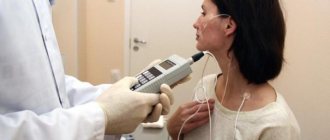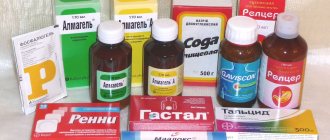How to study the acidity of gastric juice
There are several methods to determine the acidity of the stomach. Thus, fractional intubation can be performed, during which part of the stomach contents is sucked out using a special tube and then examined in the laboratory. This method is considered not very reliable, since the process of such diagnostics, which is lengthy and quite unpleasant for the patient, disrupts the natural functioning of the stomach, as a result of which the results obtained are only partially trustworthy.
Another method is called “staining the stomach wall.” Its essence is that a special dye is injected through the endoscope channel during the gastroscopy procedure. The doctor then monitors how the color of the dye changes, based on which he draws conclusions about the acidity.
Experts are also wary of this method, since it is based solely on visual data and gives only very approximate results.
The method of studying acidity using ion exchange resins is quite uninformative, although not traumatic for the patient. The patient is asked to take a special reagent that contains pigment. This dye passes through the gastrointestinal tract and is then excreted in the urine. By assessing the degree of urine coloration, doctors draw a conclusion about the acidity of the stomach.
Finally, there is another, more informative method that allows you to obtain accurate data on the concentration of acid in the stomach. This is the so-called pH-metry. The procedure involves measuring acidity in different areas of the gastrointestinal tract over a certain period of time. For this purpose, special devices are used - acidogastrometers, which are equipped with several pH sensors attached to probes.
How is ph-metry of stomach acidity performed?
In our clinic, the procedure is performed by a qualified endoscopist with extensive practical experience.
Probing types:
- Single-stage - used to take one portion of the stomach contents for the purpose of washing it in case of poisoning or feeding a seriously ill patient during a coma. A Kussmaul probe is used - a thick rubber tube 0.8 m long and an internal diameter of 0.8 cm. There are two holes at the rounded end of the probe.
- Fractional - is carried out to study the secretion of the stomach at various stages of its activity. A thin rubber tube with a length of 1.1-1.5 m and an internal diameter of 0.2-0.3 cm, called an Eingorn probe, is inserted through the mouth. There are two holes at the rounded end, and at distances of 0.5 and 0.7 m from it there are 2 marks to determine the location of the probe in the area of the fundus and pylorus of the stomach. If necessary, the position of the probe is controlled by an X-ray machine.
Indications for pH testing
First of all, you should remember that you cannot “prescribe” this procedure to yourself. A gastroenterologist exclusively refers you for examination if he believes that problems in the digestive tract may be associated with acidity problems. There are also diseases for which this study is indicated. These are peptic ulcer disease, chronic gastritis and duodenitis, pancreatic adenoma, changes in the tissue of the epithelium of the esophageal mucosa, as well as GERD.
In addition, the doctor may prescribe pH testing in order to monitor the patient’s condition after gastrectomy, as well as to monitor the effect of drugs designed to reduce or increase the acidity of gastric juice.
Finally, this diagnostic method is indicated if doctors cannot accurately determine the etiology of the disease and they doubt which method of therapy to use.
Low acidity
Low acidity of gastric juice is a common pathology that is practically asymptomatic until atrophic gastritis develops. Low secretion of hydrochloric acid leads to a weakening of the antimicrobial barrier, which leads to frequent intestinal infections and weakened gastric and intestinal motility.
Symptom complex characteristic of this condition:
- bad breath;
- lack of appetite;
- weakness, chronic fatigue;
- tendency to constipation or diarrhea;
- anemia;
- tendency to allergic reactions;
- flatulence (increased formation of gases in the gastrointestinal tract);
- recurrent stomach upsets.
Types of pH measurement
Today, there are several types of pH measurements that can solve various diagnostic problems.
The simplest method is endoscopic pH measurement. This is a procedure that only takes about five minutes. It is performed during fibrogastroscopy. A special pH probe is inserted into the instrumental channel of the endoscope, with the help of which the acidity level is established at nine points in the stomach and duodenum. The procedure is carried out under visual control. When interpreting the results, doctors take into account the fact that endoscopy itself stimulates the production of acid in the stomach.
Express research, which takes at least half an hour. In this case, the level of acidity is determined exclusively by the pH level in the so-called body of the stomach.
Short-term intragastric pH-metry. This procedure involves studying the acidity of the stomach under basal conditions, as well as when stimulated with special substances. Doctors analyze the average indicators in different departments, on the basis of which they make a general conclusion.
A daily study lasting 24 hours. At the same time, the patient is not in the hospital or in the doctor’s office all the time, but must continue his normal lifestyle and be in a familiar environment. The patient is asked to take food in the mode in which he is used to taking it, and also to record his feelings and details of his well-being in a special diary.
Which particular technique is used in each specific case depends, first of all, on the individual characteristics of the patient, as well as on the disease. All types of diagnostics, with the exception of daily diagnostics, are carried out in a hospital, patients are under the supervision of medical personnel.
Signs and treatment of high stomach acidity
Specific symptoms and signs of high acidity in the stomach can also be determined independently.
The most characteristic clinical sign of increased secretion is heartburn, which appears after the release of hydrochloric acid into the esophagus.
The provoking factor of digestive upset, as a rule, is foods that are harmful to the stomach with high acidity:
- various food additives and spices;
- citrus juices.
How to determine increased stomach acidity? First of all, you need to drink a glass of alkaline mineral water or a weak soda solution. If you feel better and the main symptomatic sign has disappeared, then you can safely talk about a clinical problem in the digestive system. Patients often complain of nausea and vomiting at the mere thought of foods that cause stomach discomfort.
You should entrust the treatment of your problem to professionals. Having determined the cause-and-effect relationship, the gastroenterologist will prescribe the necessary set of therapeutic procedures that will significantly improve the situation. On the part of the patient, one should only strictly follow the doctor’s dietary recommendations and take medications on time.
Methodology and preparation for the study
As noted above, the devices used for pH measurement are called acidogastrometers. These are flexible probes equipped with special measuring electrodes, which are inserted into certain parts of the gastrointestinal tract. The tube is inserted either through the nose or through the mouth.
The probe is installed exclusively in the morning, on an empty stomach. In this case, at least twelve hours must pass since the last meal. Smoking is also prohibited during this time. Please note that you can drink water for the last time no later than four hours before the procedure - otherwise the risk of complications when inserting the probe increases (the patient will feel nauseated and may vomit). In addition, water can reduce the acidity of the stomach, which will distort the research data, as a result of which the reliability of the results will decrease.
Before diagnosis, you should inform your doctor about what medications you are taking. Some medications should be stopped at least three days before the procedure, others should be stopped twenty-four hours before the test.
Doctors recommend that a few days before the procedure, you stop taking foods that can distort the data by changing the pH of the stomach. So, it is worth completely eliminating black coffee, strong tea, fruit juices and yogurts from your diet, or at least reducing the presence of these products on the menu as much as possible. Alcohol and carbonated drinks, as well as mineral water, should be completely excluded.
Express and short-term pH measurements are carried out in a medical office, under the constant supervision of a doctor. The patient is in a sitting position. For these studies, oral pH probes are usually used - in other words, those that are administered through the mouth. Such probes are thicker than transnasal ones, and the risk of them getting wrapped up in the stomach is an order of magnitude less.
The most frightening thing for many patients is the daily diagnosis. Typically, people are concerned about the fact that they will not have a medical professional nearby and the probe will be inside for a long time. A qualified physician should be sensitive to such experiences and explain the procedure to the patient in detail, instructing him on how to behave.
The probe for daily research is inserted through the nasopharynx, so the patient will be able to eat as usual. The recorder is attached to the belt. To make the research data more accurate and complete, the patient is asked to keep notes in a special diary. Most often, it is necessary to note the time of meals and medications, as well as indicate the periods of staying in a horizontal position. It is also necessary to record any negative sensations associated with the gastrointestinal tract - heartburn, nausea, discomfort. It is the daily diagnosis that is considered the most informative and complete and provides the maximum amount of information necessary to analyze the patient’s condition.
How to normalize acidity?
With increased levels of acidity in the stomach, drugs from the anticholinergic group, such as atropine and platyphylline, have shown their effectiveness. The aggressiveness of gastric contents is also reduced by:
- antisecretory drugs (ranitidine, omeprazole);
- antacids (Renny, Gastal).
Among the folk remedies, potato and aloe juice, propolis tincture and natural honey have proven themselves. Carrot juice and warm milk can reduce gastric secretion and, accordingly, acidity. In addition, carrot juice reduces abdominal pain, having a weak analgesic effect.
It is much more difficult to increase stomach acidity. Traditional medicine can also help: wormwood, calamus or peppermint. Herbal mixtures of chamomile, St. John's wort and herbs (wormwood) should be brewed in a thermos and taken half a glass half an hour before meals.
Drug therapy is prescribed only after a therapeutic diet has been prescribed and has had its effect. Replacement therapy includes hydrochloric acid preparations (acidin-pepsin) or drugs that stimulate the production of gastric juice. They cannot be prescribed independently and without constant supervision from a specialist.
Eating with high acidity levels
A therapeutic diet for high acidity levels is prescribed taking into account the degree of damage to the mucous membrane and the stage of the process.
During an exacerbation, the first thing you need to do is reduce any irritation of the inflamed stomach: chemical, thermal or mechanical. Food should not be too hot or cold; spicy, salty and especially sour foods should be completely excluded from the diet. The patient should chew food well and eat small portions, but often. All products are steamed or boiled. An hour before meals, the patient is recommended to drink bicarbonate mineral water.
During the period of remission, it is allowed to add carbohydrates (wheat and rye bread, cookies, crackers), lean meat, and soups prepared with vegetable broth to the diet. As before, it is better to stick to the steamed “diet” and avoid eating spicy, salty or sour foods. Mucosal-enveloping agents (natural jelly or oatmeal infusions) have a beneficial effect.
This patient is given a health education conversation about the dangers of alcohol and smoking, which stimulate the secretion of the gastric glands, which is unacceptable in a patient with a high level of acidity.
Eating with low acidity levels
Common mistakes in the treatment of low acidity levels are stimulation of secretion and attempts to artificially increase acidity. This should not be done under any circumstances, since the mucous membrane is in a weakened state; you should not load the stomach even more. First of all, it is necessary to prescribe a gentle diet with easily digestible foods.
As in the case of a high level of acidity, the dish of choice will be various porridges (oatmeal, buckwheat), rice, mashed potatoes. Products should be of a soft, uniform consistency and not hot in temperature. The patient can prepare vegetable soups, steamed lean meat and fish, and even flour. From the moment the symptoms subside, you can begin stimulating the secretion of gastric juice. Sour fruit and tomato juices and marinades help with this. Vitamins will be useful for improving general condition and as stimulators of mucosal healing.
RepostTweet
Contraindications to the procedure
Like any medical procedure, pH measurement has a fairly impressive list of contraindications. Therefore, if the doctor talks about the need for this diagnosis, it is necessary to clarify exactly what diseases you suffer from and what medications you are taking.
Contraindications to the study include not only diseases for which insertion of a gastric tube is not recommended, but also health problems for which the use of certain bioactive stimulant substances is not permitted.
Thus, a pH probe must not be inserted during gastric bleeding, as well as for ten days after it has ended. Patients with an aortic aneurysm, as well as those who have been diagnosed with coronary insufficiency and severe hypertension, should refrain from performing the procedure.
The probe should not be inserted in case of any injuries or burns of the esophageal mucosa, as well as in case of serious bleeding disorders. Reasons for refusing the procedure are also maxillofacial injuries and nasopharyngeal obstruction. Difficulties when inserting a probe may occur in patients suffering from diseases of the thyroid gland, in particular, nodular goiter.
The psychological factor is also of great importance. People with an overly labile nervous system are often simply unable to properly tune in to the procedure, as a result of which they may experience asthma attacks or panic attacks.
Best materials of the month
- Coronaviruses: SARS-CoV-2 (COVID-19)
- Antibiotics for the prevention and treatment of COVID-19: how effective are they?
- The most common "office" diseases
- Does vodka kill coronavirus?
- How to stay alive on our roads?
As a rule, such phenomena can be avoided if the doctor explains the essence of the manipulations.
What is acidity
The mucous membrane of the stomach produces a special substance - hydrochloric acid, which is part of the digestive juice and helps to dissolve food that enters the body and influence acidity. An acidic environment is normal and this is due to hydrochloric acid; its presence in the stomach is called acidity. In some cases, there is an increase or decrease in the amount of acid beyond the permissible values and this leads to various pathological processes. What is normal stomach acidity and what does it depend on? A hydrochloric acid level of 0.5% is considered the optimal concentration. In a completely healthy person, temporary jumps in acidity are possible, both downward and upward - this is a normal phenomenon and there is no reason for concern.
How can you reduce acidity?
In order for hydrochloric acid to be produced in the correct amount, it is necessary to normalize your diet and start taking medications to reduce its level. Fatty, fried, salty, sour and spicy foods are excluded from the diet. Carbonated drinks, coffee, strong tea, citrus fruits, chocolate, confectionery and sweet products are prohibited.
Eating food should be done at least 6 times a day, in fractions. Evening snacks are harmful to the body. When preparing food, preference is given to steamed, boiled and stewed foods. The food temperature should be optimally warm. At first, the patient is advised to grind food thoroughly and then chew it well.
It is preferable to introduce lean meat into the diet; rabbit, chicken, and turkey are suitable. It is better to cook porridge with milk; rice, buckwheat, oatmeal, and semolina are suitable for this. You can make cottage cheese, cheese, kefir from fermented milk, but these products should be low in fat. Yesterday's bread is suitable. It is better to refuse the loaf. Eggs must be soft-boiled.
Of the traditional methods, fresh juice from raw potatoes is considered the most effective. It should be taken 50-100 ml 20-30 minutes before meals three times a day. In order for the patient's condition to improve, the course of treatment must continue for at least one month.
Drug treatment includes taking:
- Antacids, because they create conditions for neutralizing hydrochloric acid. The most popular are Maalox, Gaviscon and Almagel.
- Antisecretory drugs such as Gastrozol, Omeprazole, Omez.
- Proton pump inhibitors (these are Nolpaza, Pantoprazole).
For peptic ulcers, De-Nol and Bismofalk are used.
Diseases that cause increased acidity
Increased production of hydrochloric acid can cause pathological conditions:
- pancreas;
- photohyperacid gastritis;
- small intestine;
- ulcers of the stomach, duodenum;
- weakening of the esophageal lower sphincter.
How to understand whether stomach acidity is increased or decreased, and how to prevent the development of diseases? To do this, you should be careful about your health and follow a dietary regime. Prevention is the best way to combat the causes that affect acidity.
Causes affecting acidity
How do you know if your stomach acidity is high or low? To answer this question, you need to know what factors influence acidity.
- Most often, imbalance occurs due to errors in nutrition. Eating large amounts of fried, pickled, fatty, smoked, and sweet foods harms the stomach.
- No diet plan.
- Eating at fast food establishments.
- Excessive consumption of processed foods.
- Addiction to fast food.
- Abuse of alcoholic beverages.
- Stressful situations.
- Constant use of hormonal, non-steroidal anti-inflammatory and other medications.
Traditional methods for determining acidity
Pain in the stomach, heaviness after eating, heartburn, sour belching, regular constipation are signs of increased acidity. Low acidity is characterized by the following symptoms: morning sickness, persistent lack of appetite, copper taste in the mouth, rumbling in the abdomen, diarrhea, belching. When the above signs are absent, this is an indicator of normal acidity in a person. How to check the acidity of the stomach using folk wisdom? Several other methods for determining acidity have been known since ancient times:
- If there is no unpleasant sensation at the sight of a cut lemon and a person can drink a sour drink on an empty stomach, then this is an indicator of low acidity. And if heartburn or nausea appears at the sight of lemon, the acidity is increased.
- If, after eating millet porridge flavored with vegetable oil, heartburn occurs, this is an indicator of increased production of hydrochloric acid.
Determining the indicator by symptoms
Increased production of stomach acid is accompanied by the occurrence of certain symptoms. Increased acidity can be identified by signs such as:
- belching and heartburn;
- sour taste in the mouth;
- heaviness and pain in the stomach;
- bloating and bowel dysfunction.
Heartburn occurs every time after eating. This symptom intensifies when lying down. This manifestation is due to irritation of the stomach walls by hydrochloric acid produced in excess. When acidity is reduced, there is a disruption in the digestive process, incoming food is poorly broken down, and the absorption of vitamins and microelements worsens.
A decrease in the concentration of gastric juice has similar manifestations as when it increases, with a slight difference. Signs of a lack of gastric juice are belching with a rotten smell, constant rumbling in the stomach, and a decrease in hemoglobin levels. If we talk about the general reaction of the body, then immunity decreases, a person becomes susceptible to infection with various viruses and bacteria. In addition, reduced secretion of hydrochloric acid in the stomach can provoke cancer of this organ.
A decrease in stomach acidity will be indicated by additional manifestations such as:
- helminthic infestation;
- nail fungus;
- brittle nails and hair;
- transillumination of blood vessels on the face;
- the presence of undigested food residues in the stool;
- acne on the body and face.











